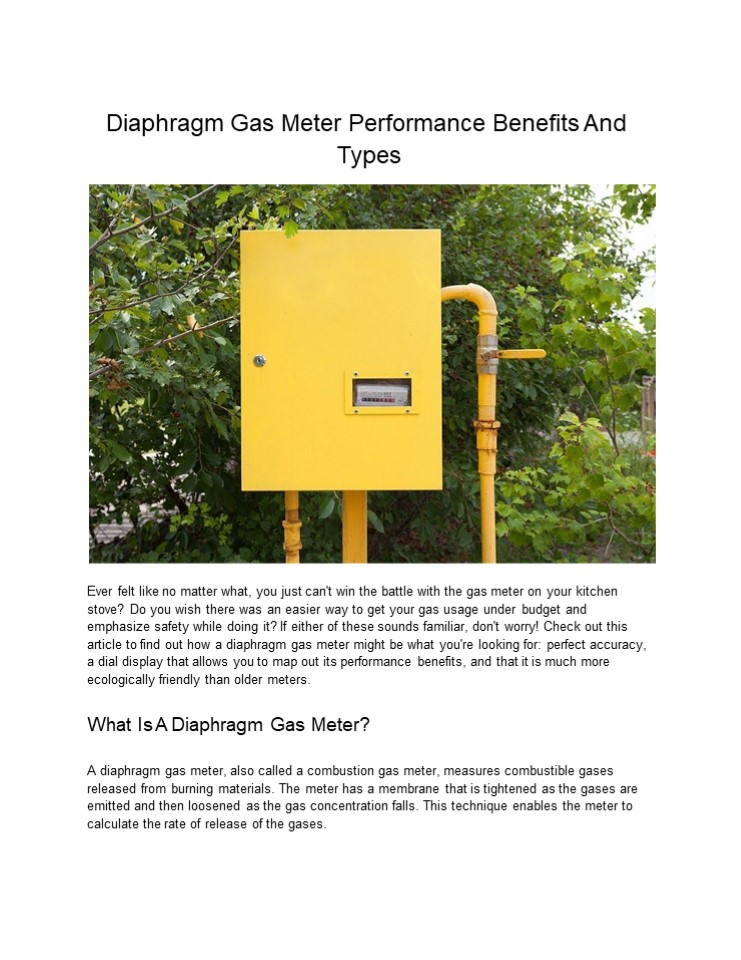Diaphragm Gas Meter Performance Benefits And Types - PowerPoint PPT Presentation
Title:
Diaphragm Gas Meter Performance Benefits And Types
Description:
A diaphragm gas meter, also called a combustion gas meter, measures combustible gases released from burning materials. The meter has a membrane that is tightened as the gases are emitted and then loosened as the gas concentration falls. This technique enables the meter to calculate the rate of release of the gases. Learn more in this PDF! – PowerPoint PPT presentation
Number of Views:3
Title: Diaphragm Gas Meter Performance Benefits And Types
1
Diaphragm Gas Meter Performance Benefits And
Types
Ever felt like no matter what, you just can't win
the battle with the gas meter on your kitchen
stove? Do you wish there was an easier way to get
your gas usage under budget and emphasize safety
while doing it? If either of these sounds
familiar, don't worry! Check out this article to
find out how a diaphragm gas meter might be what
you're looking for perfect accuracy, a dial
display that allows you to map out its
performance benefits, and that it is much more
ecologically friendly than older meters. What Is
A Diaphragm Gas Meter? A diaphragm gas meter,
also called a combustion gas meter, measures
combustible gases released from burning
materials. The meter has a membrane that is
tightened as the gases are emitted and then
loosened as the gas concentration falls. This
technique enables the meter to calculate the
rate of release of the gases.
2
The main performance benefits include accurate
measurement of combustible gas concentrations in
ambient and confined spaces, minimizing the
chance of misreadings, and fast processing time
thanks to electronic sensors. Both mechanical and
electronic meters use mercury-arc plungers while
capacitors. How Does It Work? The diaphragm gas
meter measures the level of natural gas in the
ground and can provide a valuable performance
benefit to your facility. Its accuracy and
reliability depend on specific factors, such as
the type of diaphragm meter and soil
conditions. There are three types of diaphragm
meters static displacement, capacitance, and
inductance. Static displacement meters use a
metal cup that moves up and down with changes in
gas pressure acting on it. In contrast,
capacitance meters measure energy storage by
measuring how much charge is transferred when
two metal plates are pressed together. Inductance
meters use a coil to sense the current flowing
through it and use that information to calculate
Gas Volume Equivalent (GVÉ). Static
displacement meters are often used for detecting
leaks near wells. Capacitance meters are
commonly used in Buildings and Facilities
Management (BFM) applications because they can
identify alterations to HVAC units or evaporation
from roofs. Inductance meters are most widely
used in Natural Gas Distribution (NGD)
applications because they can indicate line
losses or potential methane venting from
wellheads or pipelines. Differentiating between
these types of meters can be important when
choosing a monitoring solution for your
site. The maintenance procedure for a diaphragm
gas meter is to check the pressure gauge
regularly and change the diaphragm when it shows
signs of wear. It should also be flushed with
clean water every three to six months, depending
on its type. Benefits Of Using A Meter A
diaphragm gas meter is critical for measuring and
managing natural gas usage. The meter measures
the amount of gas being consumed, allowing you to
take action to conserve energy and protect your
wallet. Here are some benefits of using a
meter A diaphragm meter can help you save on
your energy bill by helping you identify patterns
in your energy use. Knowing how much gas is
being used each day, you can adjust your
lifestyle and reduce your overall
consumption. Conserving natural gas can
positively impact the environment, reducing
greenhouse gas emissions and contributing to
global warming prevention efforts. It can help
you save on your
3
energy bill by helping you identify patterns in
your energy use. Knowing how much gas is being
used each day, you can adjust your lifestyle and
reduce your overall consumption. Conserving
natural gas can positively impact the
environment, reducing greenhouse gas emissions
and contributing to global warming prevention
efforts. Proper installation and maintenance of
diaphragm meters can help prevent dangerous
methane leaks. Types of Diaphragm Gas
Meters There are various diaphragm gas meters,
each with its performance benefits. Photoelectric
Diaphragm Gas Meters The photoelectric type is
the most common type of diaphragm meter. It works
by using an image sensor to take a picture of
the gas flow and counting the times that image is
reflected in the sensor. This meter is simple to
use, accurate and needs no calibration. However,
it may not be appropriate for high-volume
applications. Capacitive Diaphragm Or
Piezoelectric Chargers Capacitive diaphragm or
piezoelectric chargers use microscopic metal
plates that are charged by electromagnetic
fields when a gas molecule contacts it. These
meters are fast and accurate, but they require
particular installation (in combination with a
monitor) because they operate on AC power rather
than battery power, like most other meters.
They're also more expensive than photoelectric
meters, but they're ideal for applications
requiring quick response (such as emergency
monitoring). Micro Flowmeters Micro flowmeters
are similar to photoelectric meters in that they
use an image sensor to take a picture of the gas
flow and then count the number of times that
image is reflected in the sensor. Conclusion A
diaphragm gas meter is vital for measuring
emissions and controlling gas supply. They are
also used to measure carbon monoxide (CO) levels,
which can indicate if there is a problem with
the flue gases from a CHP unit.































